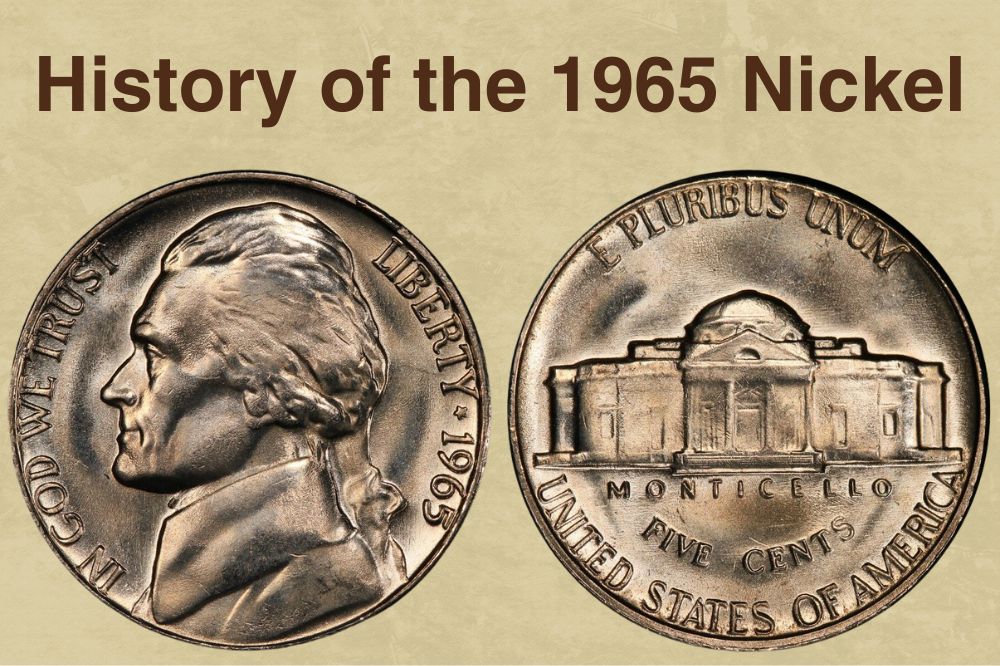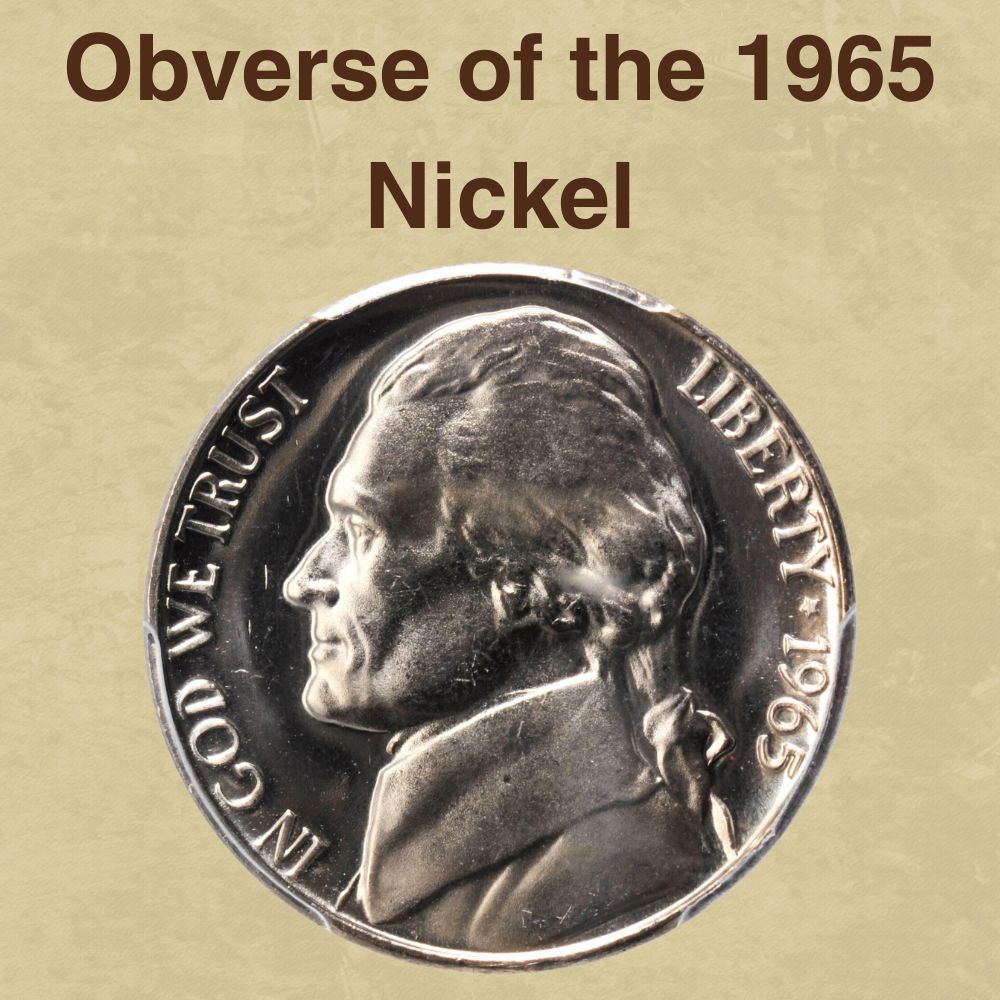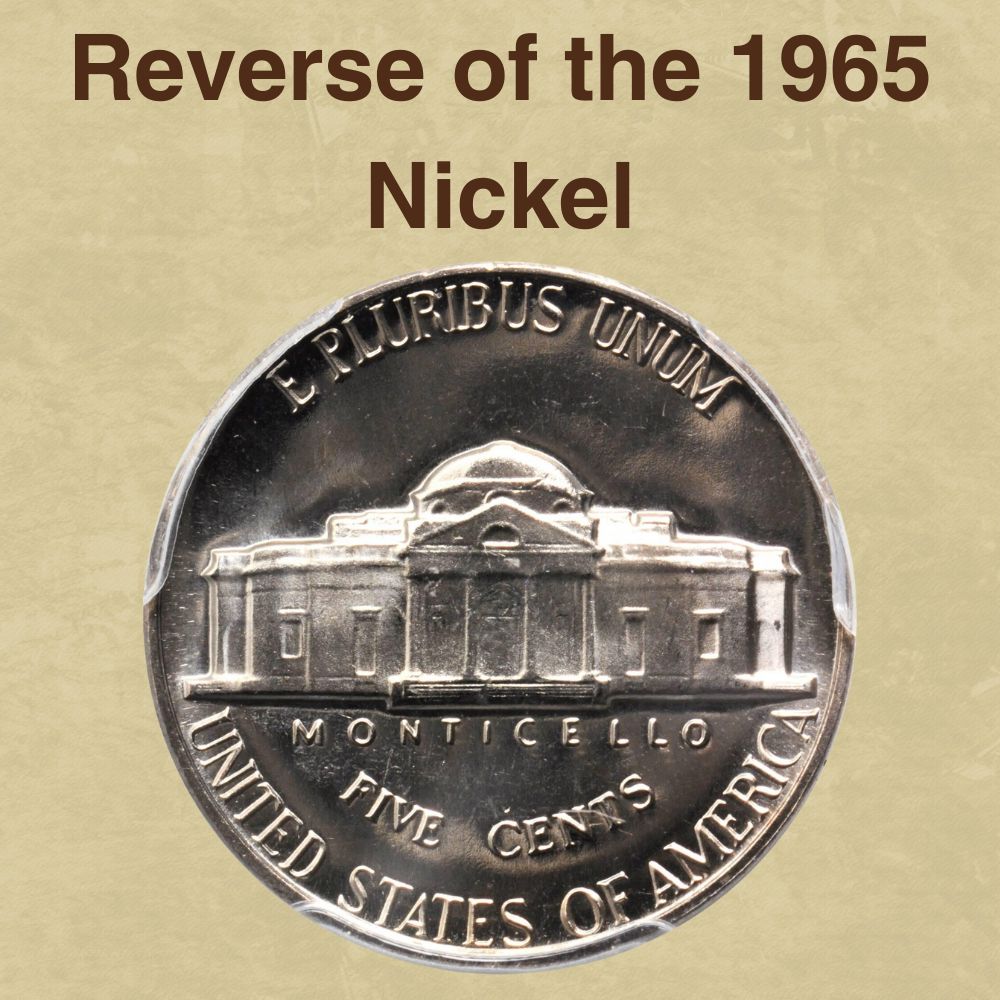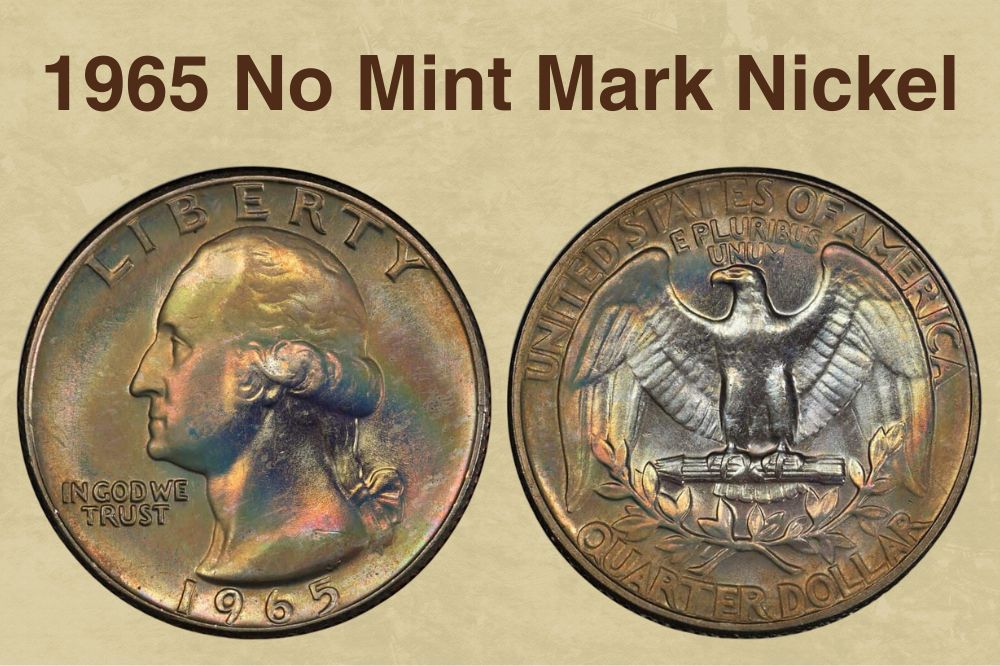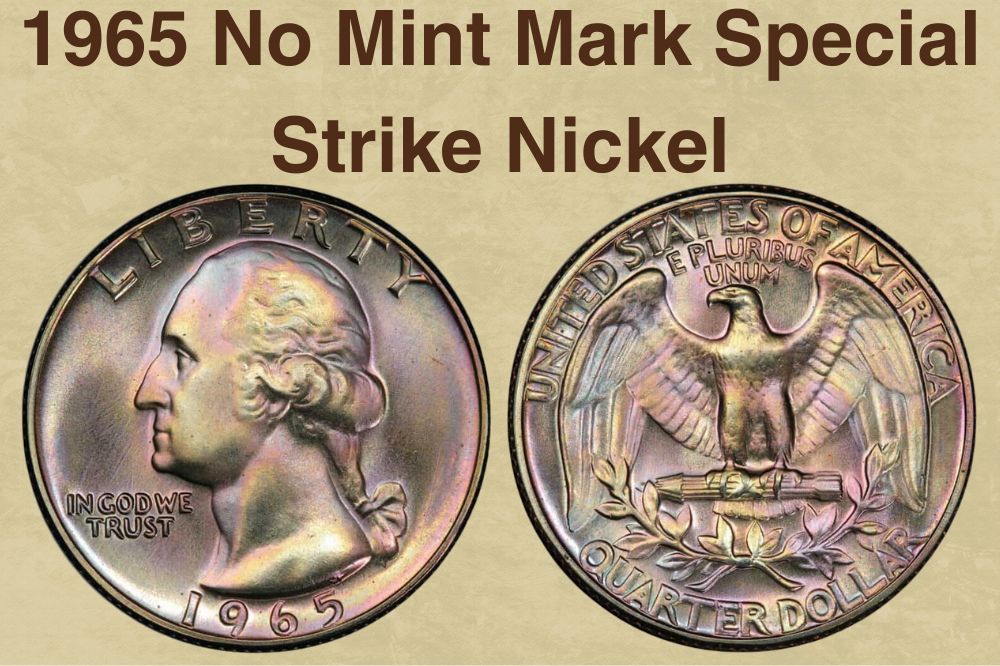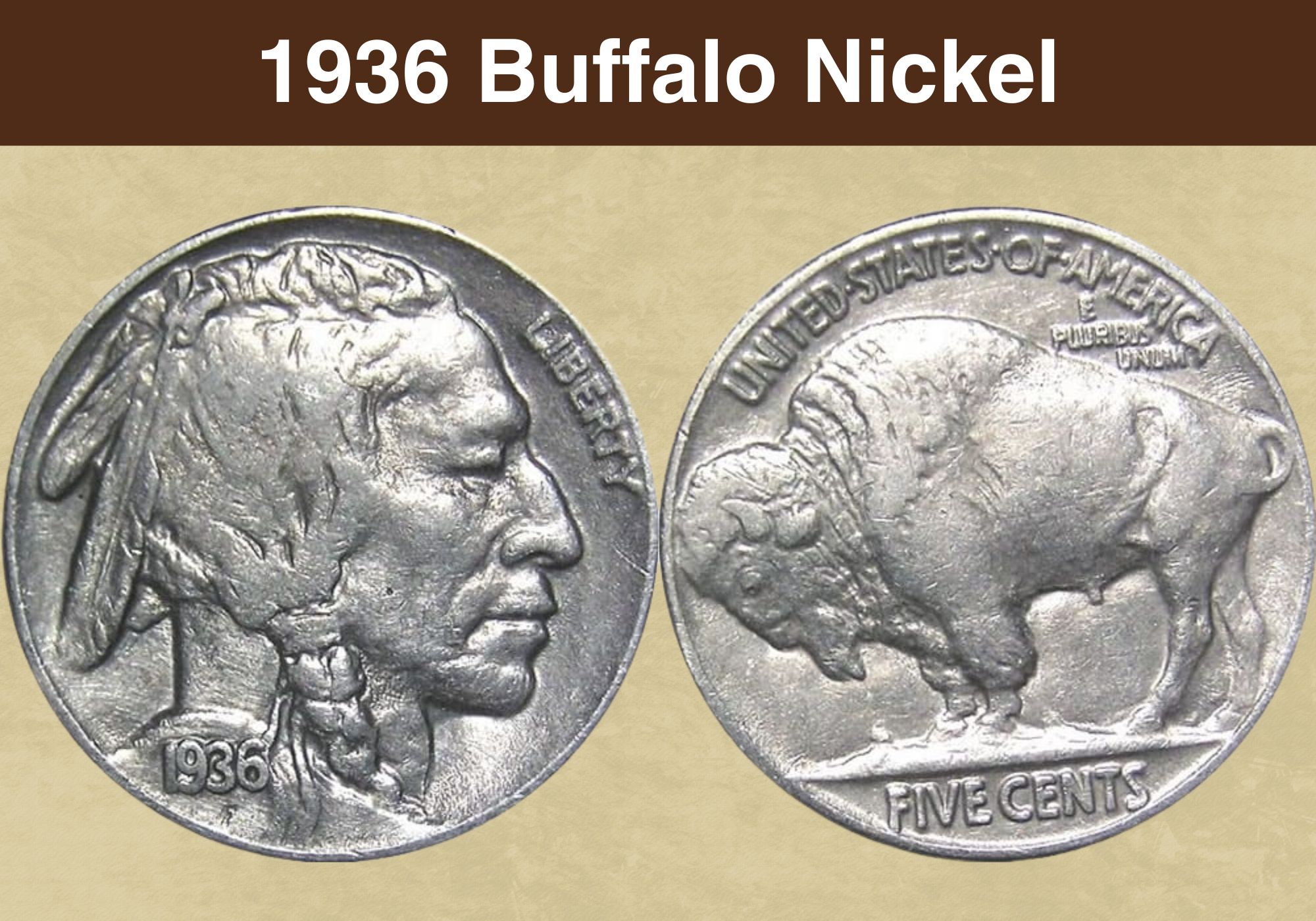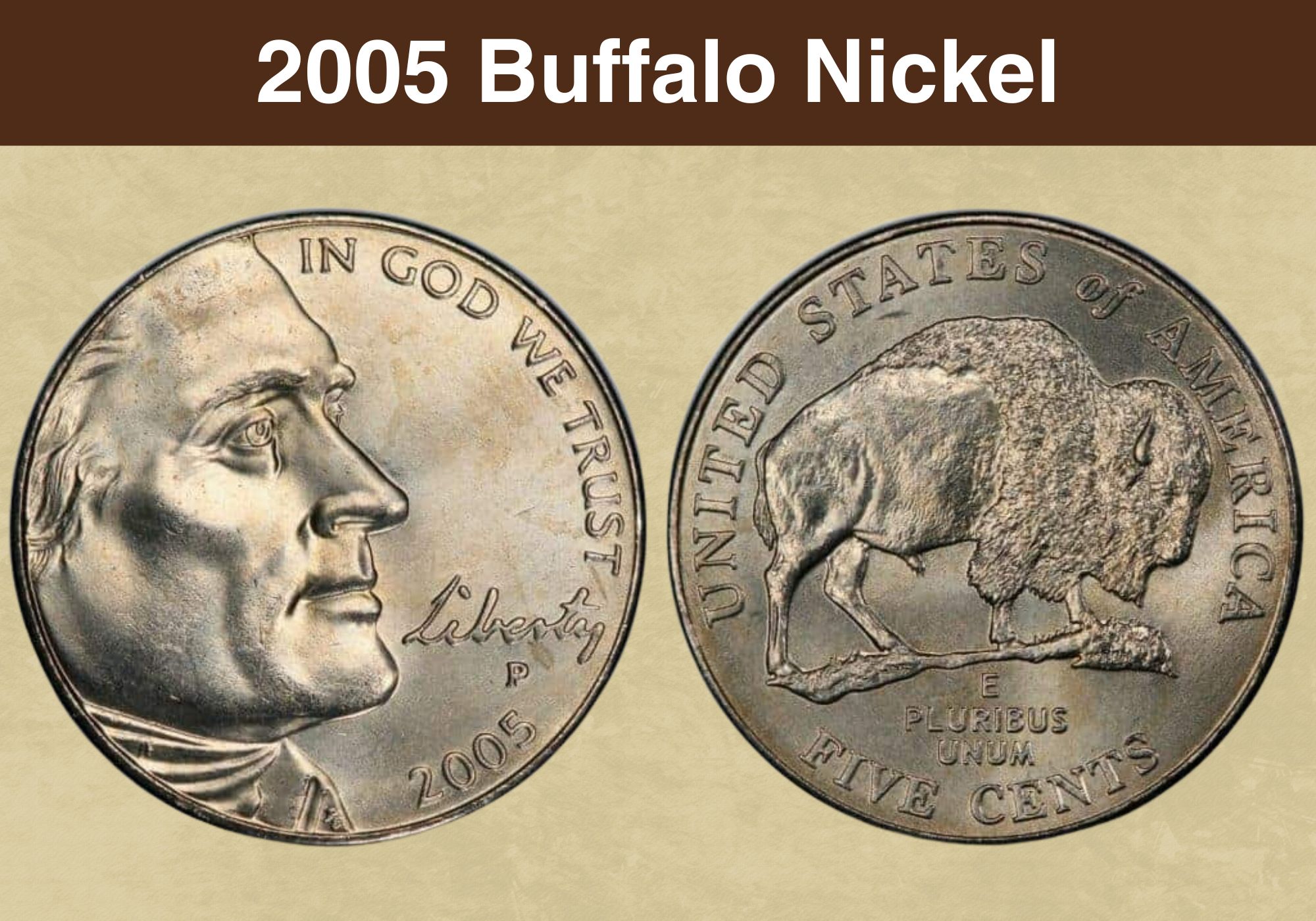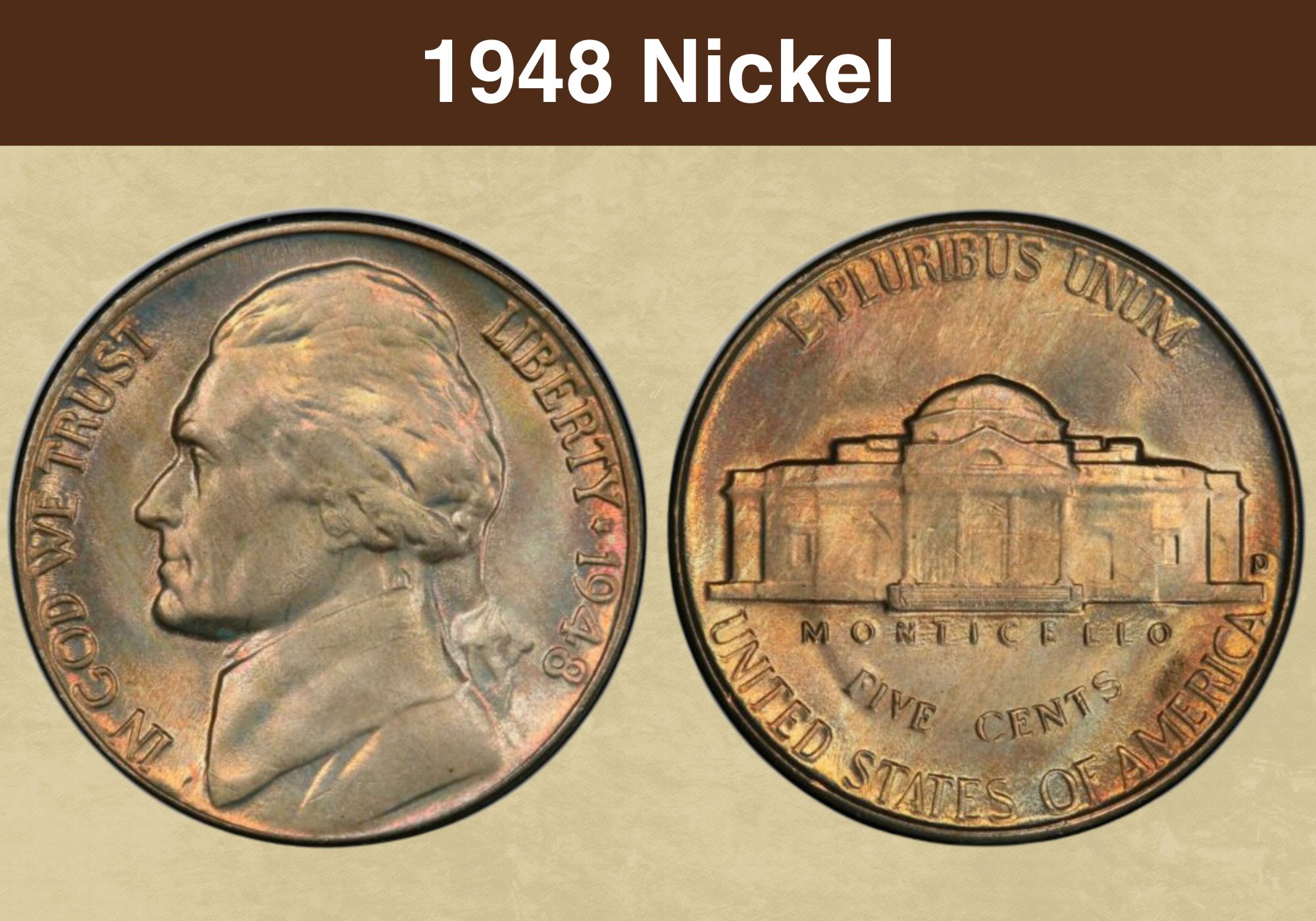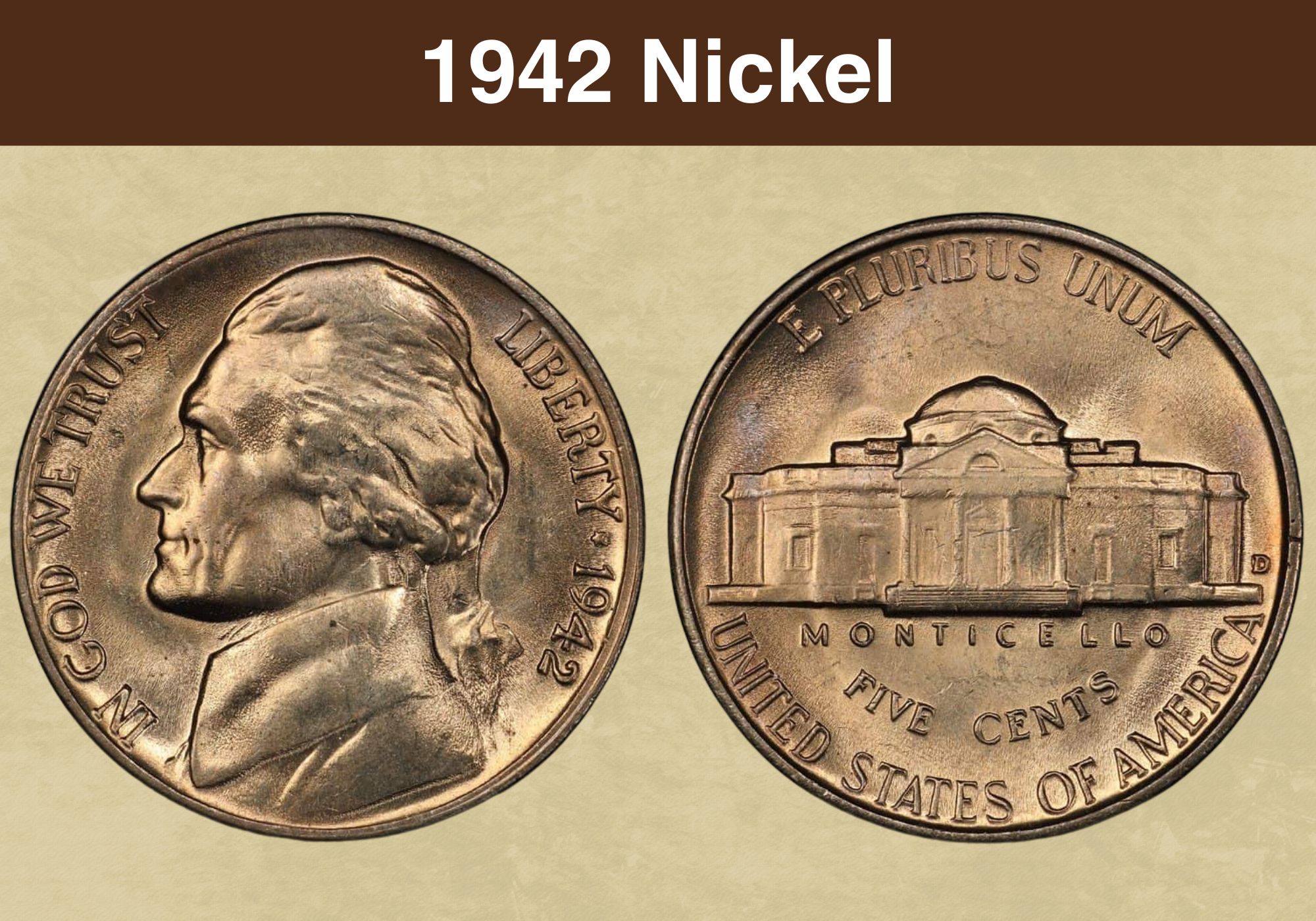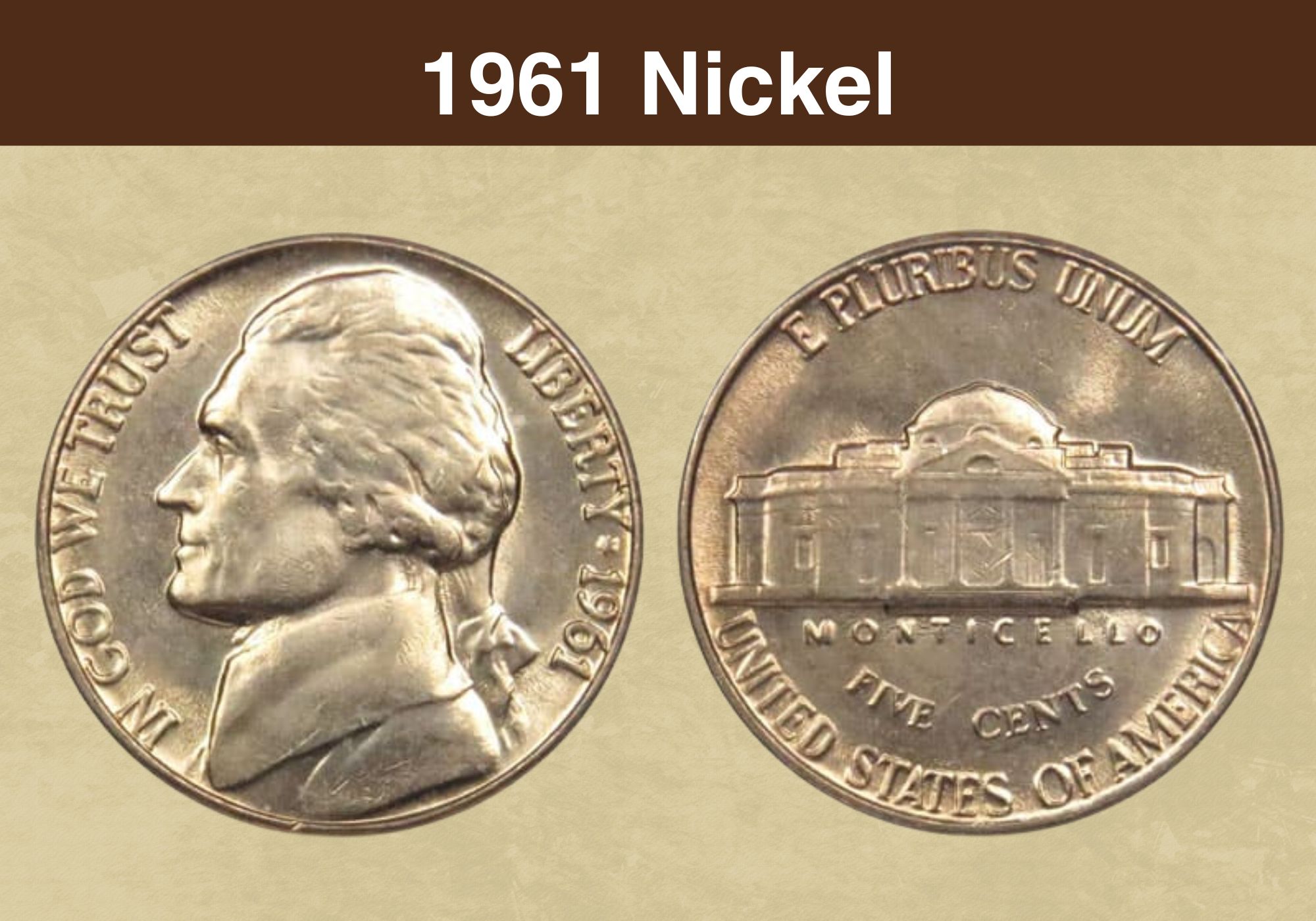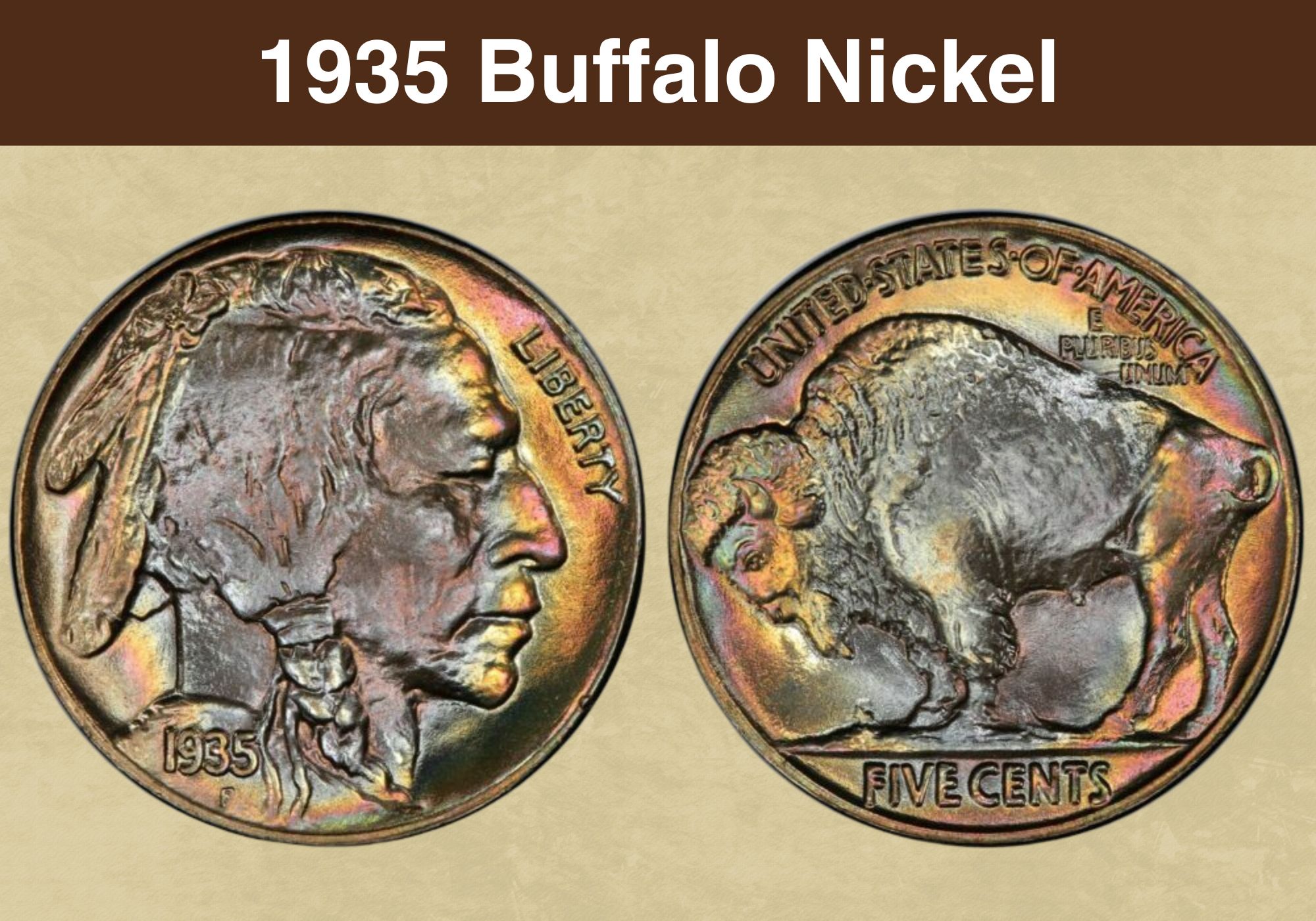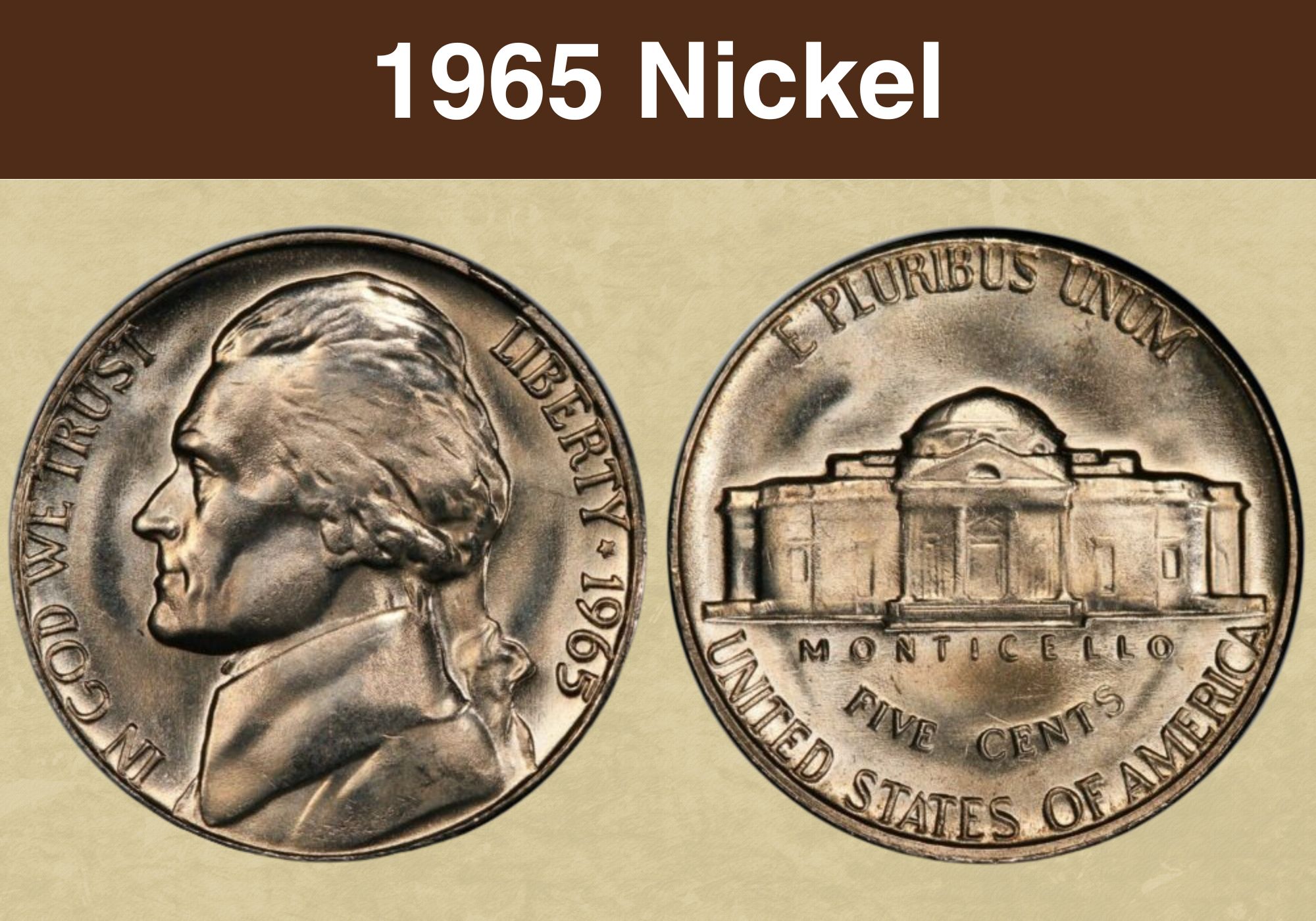
Coin Value Contents Table
The nickels struck in the 1960s were known as Jefferson nickels. Individual coins can vary hugely in value. So just how much could a top quality coin be worth?
That’s what we’re going to find out! We’ll explore one particular mintage – the 1965 nickel value. We’ll dig into what separates a standard coin from something that’s rare and valuable. And we’ll take a look at the history and design of the Jefferson nickel along the way.
Ready to find out more? Then let’s get started!
| 1965 Nickel Value Chart | ||||
| Mint Mark | XF45 | MS60 | MS65 | MS67 |
| 1965 No Mint Mark Nickel Value | $0.05 | $1 | $15
Full step: $10,000 |
$2,000 |
| SP60 | SP65 | SP67 | SP69 | |
| 1965 No Mint Mark Special Strike Nickel Value | $3
Cameo: $4 |
$10
Cameo: $18 Deep cameo: $425 |
$26
Cameo: $210 Deep cameo: $3,500 |
$700+ |
History of the 1965 Nickel
1965 marks the first date of the series known to coin collectors as the “modern original design” Jefferson nickel.
Earlier nickels are known as “vintage”, but there’s no real difference between them. The distinction simply ties in with the date when the Treasury removed silver from dimes, quarters, and half dollars.
The 1965 nickel has the same design on both sides as the earliest Jefferson nickels, which were struck in 1938. The coins get their nickname from the obverse, which carries the portrait of the former president, Thomas Jefferson.
The Jefferson nickel was a replacement for the coin known as the Buffalo nickel. That had proven difficult to strike successfully and was retired after 25 years. That was the earliest the Mint could cease producing a coin design without seeking Congressional approval.
The new nickel was designed by a German-born sculptor by the name of Felix Schlag. Schlag had served in the German army in the First World War, but emigrated to the USA in 1929.
The first Jefferson nickels didn’t have Schlag’s signature. This was unusual, and in 1966, the US Mint gave the artist the opportunity to remedy the situation. His initials were placed on the obverse, at the base of Jefferson’s portrait.
They remained there until 2005, when the image was replaced with a portrait of Jefferson in three-quarters profile.
At first, Jefferson nickels were produced by the Mint facilities at Philadelphia, Denver, and San Francisco. But in 1965, all nickels came out of Philadelphia.
There were no proof nickels that year either. But the Mint did produce special strikes – coins that could be purchased alongside other denominations in Special Mint Sets. These too were struck in Philadelphia.
Jefferson nickels are still being struck to this day. The portrait used for today’s versions is by Jamie Franki.
Also read: Top 10 Most Valuable Nickels Worth Money
Features of the 1965 Nickel
The Obverse of the 1965 Nickel
Coin collectors call the “heads” side of a coin its obverse. The obverse of the 1965 nickel has the portrait of Thomas Jefferson. Jefferson was one of the Founding Fathers, and President of the USA from 1801 to 1809.
The Mint ran a competition to seek designs for the coin. The winner was a German artist called Felix Schlag. His portrait depicts Jefferson in profile, facing to the left as the coin is viewed, and wearing a slight smile.
Schlag’s Jefferson looks very similar to a bust of the former president by the French artist, Jean-Antoine Houdon. You can take a look at the original sculpture if you visit the Boston Museum of Fine Arts.
To the left of the portrait is inscribed the motto “IN GOD WE TRUST”. The words curve to run parallel to the edge of the coin, facing Jefferson. To the right of the portrait is the word “LIBERTY” and the date.
You won’t find any mint marks on 1965 nickels. That’s because they were all struck at the Philadelphia Mint facility, which didn’t routinely use mint marks until the late 1970s.
The Reverse of the 1965 Nickel
Like the obverse, the reverse of the 1965 nickel was designed by Felix Schlag. But it looks quite different from the version that won him the design competition.
Like the earlier version, it shows Monticello, Jefferson’s home on his sprawling Virginia estate. But on the coin, Monticello is shown face on, with a legend beneath identifying it.
Schlag’s original design had been much more striking. It had shown Monticello from a three-quarters angle, with a tree to one side.
While art historians generally prefer the original design, Mint officials at the time felt very differently. They mis-identified the tree as a palm, and claimed it could not have been grown in Virginia. And they felt the unusual angle was not “fitting” for a coin.
They also required a change to the font used for the inscriptions. Schlag’s earlier design had used elegant art deco lettering. But the Mint officials preferred a more traditional typeface with serifs.
That’s used for the phrase “E PLURIBUS UNUM”, the label “MONTICELLO”, the denomination, and the country name.
The Latin motto means “From the many, one”, and refers to the country’s genesis as a union of states. It’s positioned at the top of the coin, curving parallel to its upper edge.
Both the denomination – inscribed in full as “FIVE CENTS” – and the country name appear below the image of Monticello. And both curve parallel to the lower coin edge.
Other Features of the 1965 Nickel
The 1965 business strike nickel – i.e. the coins intended for everyday use – can be found in two variants. That’s because most coins don’t have clear lines separating each of the five steps in front of Monticello.
The coins that do have this level of detail are known as “full step”. And because they’re relatively rare, they command a premium.
Although the 5-cent piece is commonly known as a nickel, Jefferson nickels are made mostly of copper. The silver color does, however, come from a small amount of nickel in the recipe. That accounts for just 25 per cent of the weight.
Each nickel measures 21.2 millimeters in diameter and weighs 5 grams. And if you turn it on its side, you’ll see that it has a plain edge.
To look at the design of the Jefferson nickel in more detail, check out the examples in this Youtube video from CoinHELPu.
Also read: Top 17 Most Valuable Buffalo Nickel Worth Money
1965 Nickel Grading
| # | Grade |
|---|---|
| 1 | Basal State-1 |
| 2 | Fair |
| 3 | Very Fair |
| 4, 5, 6 | Good |
| 7, 8, 10 | Very Good |
| 12, 15 | Fine |
| 20, 30 | Very Fine |
| 40 | Extremely Fine |
| 50 | About Uncirculated |
| 60 | Mint State |
| 65 | Mint State |
| 70 | Mint State |
Please check our grading guides to know your coin scale, It’s the necessary step to know the exact value of your coin.
Check out now: How to Grade Jefferson Nickel?
1965 Nickel Value Guides
1965 No Mint Mark Nickel Value
In 1965, the Mint facility at Philadelphia was the only one to strike nickels. It produced over 136 million “business strike” nickels that year. These were coins that were intended for everyday use.
In circulated condition, they remain easy to find. And unless your coin has an interesting Mint error, it’s unlikely to be worth more than its face value.
But if you’re looking for a better quality coin, you’ll need to search harder – and be prepared to pay more.
Coins with a good enough strike to be designated “full step” are scarce. The independent coin grading agency, the PCGS, estimates that only around 1,000 survive.
The coin grading scale runs from 1 to 70. Coins graded 1 are those in the poorest condition – although it must still be possible to identify the mintage and denomination. Those graded 70 are perfect.
And 60 and above is used for coins that are in “mint state”. Those have never been circulated, so have minimal signs of wear.
A standard 1965 nickel graded MS60, the lowest grade for mint state coins, is worth around a dollar. That rises to $15 at MS65, the lowest level at which a coin is considered to be in “gem” condition.
The most valuable standard 1965 nickels are graded MS67. The PCGS has certified nine coins at that level, and values them each at $2,000.
If you want a 1965 nickel with the full step designation, you’ll have a smaller choice. Full step coins have been certified only at grades MS63 to MS66.
At the lower end of that scale, an MS63 example is valued by the PCGS at $250. That jumps to $2,000 for a coin graded MS64, and to $10,000 for the sole example graded MS65.
But the best of the best are two nickels graded MS66. And those are worth an astonishing $40,000 apiece.
1965 No Mint Mark Special Strike Nickel Value
The Mint often produced high quality coins known as proofs for collectors. These are prepared using specially crafted dies and highly polished planchets.
No proof nickels were made in 1965. But instead, collectors could purchase “special strike” coins. These were better quality than business strikes, but not quite as good as proofs. They were presented in Special Mint Sets with coins of other denominations from the same year.
Special strike coins are identified by the prefix “SP” in the grading. Values for a 1965 special strike nickel start at around $3 for a coin graded SP60. For a gem quality SP65, the value rises to $10, and at SP67, it’s around $26.
Higher values are afforded to coins designated as “cameos” or “deep cameos”. These have an attractive contrast between highly polished fields – the flat parts of the coin – and frosted devices. If the contrast is very strong, the coin is classified as a deep cameo.
Cameo versions of the 1965 special strike nickel are available at grades from SP60 to SP68. The PCGS values an SP60 example at $4, an SP65 at $18, and an SP67 at $210. Six cameos have been certified at SP68, and those are valued at $1,500 each.
For deep cameos, the grading range is narrower, from SP63 to SP67. The former is valued at $100, while a gem SP65 is worth around $425.
And the crème de la crème, deep cameos graded SP67, are each valued at $3,500. That relatively modest figure reflects the fact that, to date, 16 coins have been certified at that level.
Also read: Top 17 Most Valuable Jefferson Nickels Worth Money
Rare 1965 Nickel Errors List
1965 (P) No Mint Mark Nickel, Foldover Strike
A foldover strike occurs when the planchet is struck on the edge, and folds over as a result.
This happened to one 1965 nickel which ended up with an irregular shape, and missing the top part of the design. The word “America” on the reverse was distorted out of all recognition too.
The coin was graded MS64 by the coin grading agency the NGC. And the unusual nature of the error meant that when it was presented at auction, it sold for $4,300.
1965 Nickel, Struck on Clad 10-cent Planchet
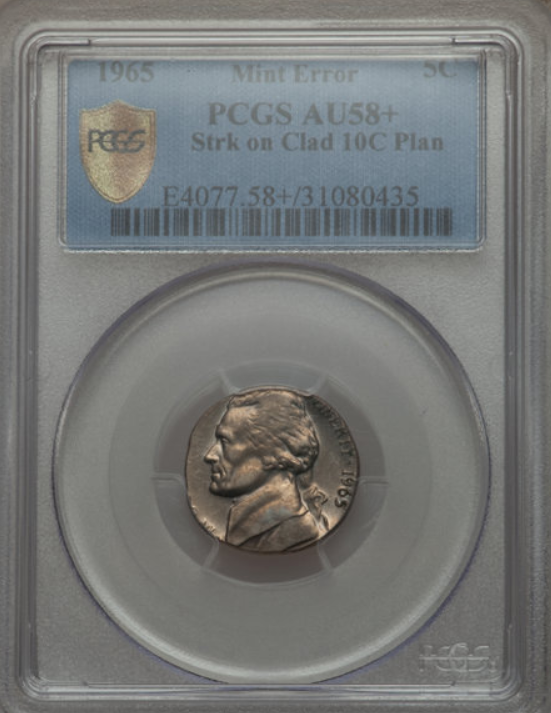
Very occasionally, coins are struck on something other than the correct planchet for their denomination. That happened to one 1965 nickel which was somehow struck on a planchet intended for a dime.
The smaller surface area meant that the top of Jefferson’s head was positioned at the very edge of the obverse.
The coin was certified by the PCGS and graded AU58+ (the letters stand for “about uncirculated”). And when it was offered for sale at auction, it achieved a price of $325.
This YouTube video from Couch Collectibles shows both these examples, as well as other interesting 1965 nickels with errors.
Also read: 14 Most Valuable Nickel Errors Worth Money
Where to Sell Your 1965 Nickel ?
Now that you know the value of your coins, do you know where to sell those coins online easily? Don’t worry, I’ve compiled a list of these sites, including their introduction, pros, and cons.
Check out now: Best Places To Sell Coins Online (Pros & Cons)
FAQs
How much is a 1965 nickel worth today?
Most 1965 nickels are circulated coins with signs of wear and tear. Those are only worth their face value.
But if they’re in excellent condition, or have an interesting Mint error, they could be worth much more. The very finest examples can make many thousands of dollars.
A good starting point to determine coin quality is to look closely at the steps in front of Monticello, on the reverse of the coin. If all five steps are clearly and completely separated from one another, your nickel could be collectable.
How much is a 1965 nickel with no mint mark worth?
Not having a mint mark doesn’t affect the value of a 1965 nickel.
Two types of nickels were struck in 1965 – business strikes and special strikes. Neither type have mint marks. That’s because they were both struck at the Mint facility in Philadelphia, which wasn’t using mint marks at the time.
Is a 1965 nickel real silver?
Although the 1965 nickel is silver in color, it isn’t made of silver. It’s 75 per cent copper and 25 per cent nickel. The silver color comes from the nickel content.

